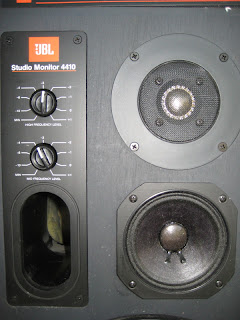In our last episode it had become clear that
Li'l Mar, the cute as a button, but sonically distressed
Marantz 4220 quad receiver, was trouble. Evidently she is what might be described as high maintenance as we continue with the
anthropomorphization of Li'l Mar.
Episode 1 saw a routine re-capping of the phono and regulator boards, and
Episode 2 involved a fairly challenging but successful recapping of the power amp. At this point the ugly reality was clear: something was seriously wrong with the front end of this receiver.

Receiver preamps are a physical challenge to work on. They are typically on boards that contain pots and switches, and are therefore attached directly to the back of the face plate. So first you have to pull the knobs, remove the control retaining screws and unscrew the face plate. But since the preamp controls the operation of the rest of the unit via a web of wires, lots of tugging (and sometimes snipping) is required to actually pull the board free and get sufficient room to maneuver with a soldering iron. And amidst the pots and wires lie a bevy of tiny caps inserted long ago by people with tiny, young fingers...
Marantz gear is generally well made. Some receivers, notably the 2275, are a joy to work on. However, many Marantz boards, especially the smallish and dense ones, are soldered in a manner that is very difficult to work on. The parts were mounted in the factory with the longish leads folded over, in many places leading to a bit of a tangle. Removing a single cap can disturb the leads of 4 or 5 other components. Often the lead you are trying to free lies at the bottom of a pile of leads, folded over every which way. And often these boards do not have the stoutest of traces. Hot pulls are out of the question, this work requires solder wick in vast quantities.
So, yes, Li'l Mar's preamp board was difficult to remove, and once removed, difficult to work on.
Episode 3 in this condensed tale of woe was the recapping of the preamp. It was tough going with several tiny traces vanishing despite careful wicking. A total of 19 caps were replaced on the board, seemingly for naught. The sound was cleaner, but still weird. Sigh. Balance sliders had little or no effect, one channel was weak, and the tone controls seemed to behave like balance pots.
Time passed, hope sprung anew. Episode 4 started with pulling the preamp board again in anticipation of a high gain, low noise transistor replacement orgy. But a bit of perusing revealed a lot of wires wandering through the quad board tacked upside down underneath the switching control rods running to the back of the unit. After a bit of agonizing I determined that recapping the quad board was the path of least resistance. Here's a close up, before the re-cap:

An hour, 2 snipped wires and 14 caps later the work was complete, for semi-naught. The weak channel seemed better, but nothing else improved. So it was time to replace 8 very tiny transistors in the preamp. Very slowly. Here's a closeup of the dangling, re-capped preamp:

Preamp caps are low value, tiny, two legged beasties that are fairly easy to locate on the solder side of the board. The three legged transistors are even smaller and not so easy to locate. And they are basically impossible to grab with a finger unless you are under the age of 12. After a very challenging effort, 8 transistors were replaced. Fingers were crossed and a listen taken with boards dangling and Mar on her side.
Hmm. The front channel seemed slightly better, but the rear channels were there. Significant improvement, but not a resolution. It seems there will be (at least) an Episode 5.

















































